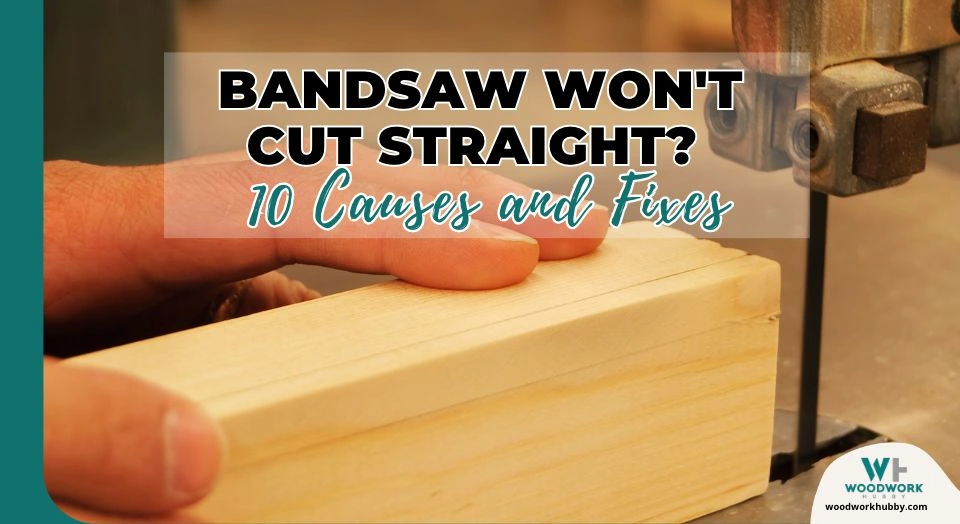I love my bandsaw but one thing that really annoys me is a blade that just won’t cut straight. I recently encountered this problem so I decided to look into why it was happening. Here is what I found.
Below are 10 reasons why your bandsaw does not cut straight:
- Incorrect Blade
- Blade is Dull
- Pushing material through too hard
- Tension on the blade is incorrect
- Blade guides are incorrectly set
- Sawing too fast
- Blade or machine is hot
- Blade installed incorrectly
- Blade going wrong direction
- Bandsaw wheels or worn out
Bandsaw blades can be tricky to adjust properly. There are times when the blade of the saw will not cut properly, and it ends up being a not-so-straight line. There are a lot of different reasons that this could happen, but you must find out the causes so that you can get back to having pristinely cut wood. Once you understand the cause, it will be much easier to find a solution!
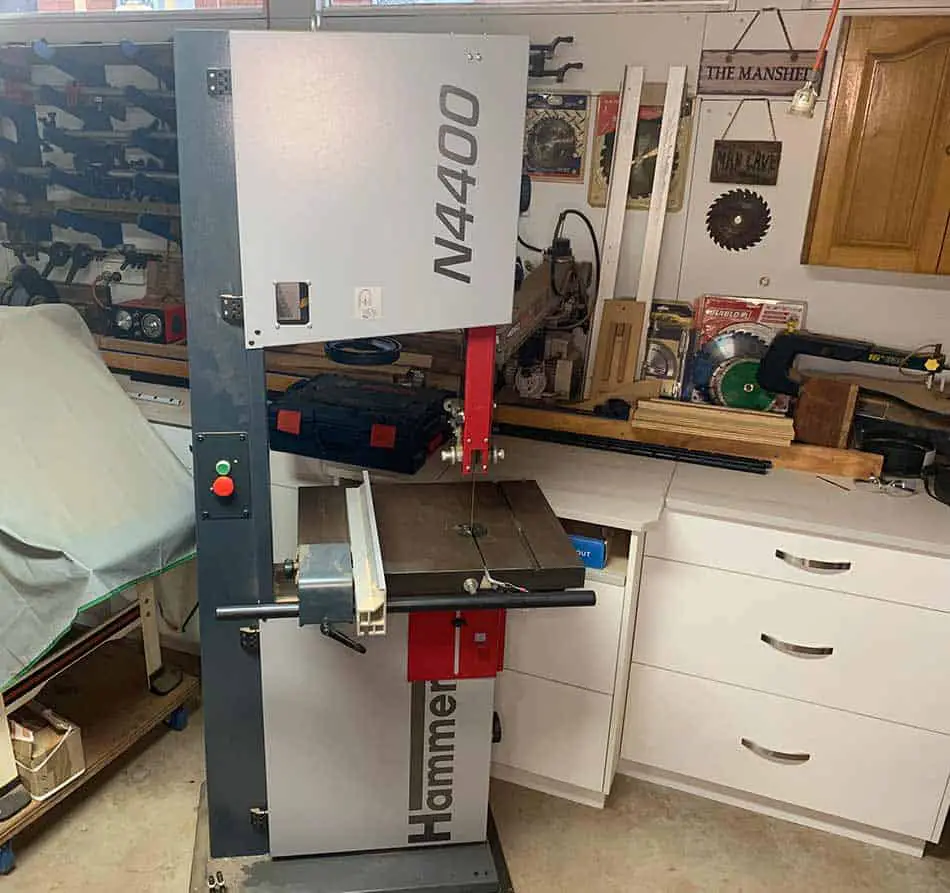
1. Incorrect Blade
Cause
All bandsaw blades are made for different reasons. For example – a wide blade is meant for cutting straight lines and thick timber. A narrow blade is designed for cutting tight curves. If you are attempting to cut some thicker wood with a narrow blade you can very well find the blade will start to wander.
On the blade, there is a specific number of teeth per inch. The difference in the teeth per inch can change the alignment, and mess with the attachment of the blade to the saw. This in turn causes the blade to not cut in a straight line. It also means the blade will not be able to go at the speed it normally would, making it even harder to cut in a straight line.
An easy way to solve this problem is to buy and install the correct blade. When using the correct blade, it is easier to push and cut the material than it would be if you were using the wrong one.
Check-in with the supplier on what blade is typically used for your type of project or your particular type of bandsaw. This can depend on the width/depth of the blade and teeth per inch, as well as the size of the bandsaw.
The most commonly used saw width/depth type is 1/8″. Other options that are common are 1/4″, 1/2″, and so on. There is the ratio because it has to match up with the wheel diameter—if it is too thick, the blade will crack.
The teeth per inch (TPI) also matter if you want to use your saw correctly and get it to cut as you desire. 4 TPI is for coarse cuts, 6-8 TPI meets most needs, and 10 or more TPI is for fine cuts.
This handy chart will outline exactly which blade you should be using.
| Wheel Diameter | Recommended Blade Thickness |
| 4-6 Inches | .014″ |
| 6-8 Inches | .018″ |
| 8-11 Inches | .020″ |
| 11-18 Inches | .025″ |
| 18-24 Inches | .032″ |
| 24-30 Inches | .035″ |
| 30 Inches and Above | .042″, .050″, .063″ |
2. Blade Is Dull
Cause
A dull blade happens over time through the use of the blade. With a dull blade, there is an expectation for it to cut slower and cut crooked. Bandsaws are used on other materials than wood, such as plastic and resin. Those materials are hard on the tips of the teeth, causing the sharpness to dull down. When the sharpness is dulled, the saw must use more effort and force to push the material through. The amount of force that is being pushed can cause the blade to twist to the right or the left while working, resulting in a crooked cut.
Fix
The answer is simple: replace the blade. Replacing the dull blade with a new, sharp one, will help push the materials through the saw blade easier. The sharper blades make cutting a smoother process. The process requires little from the operator and is cut in a straight line by the machine.
Does your bandsaw blade keep breaking? Check out this article showing how to stop this from happening.
3. Pushing Material at the Saw with Too Much Force
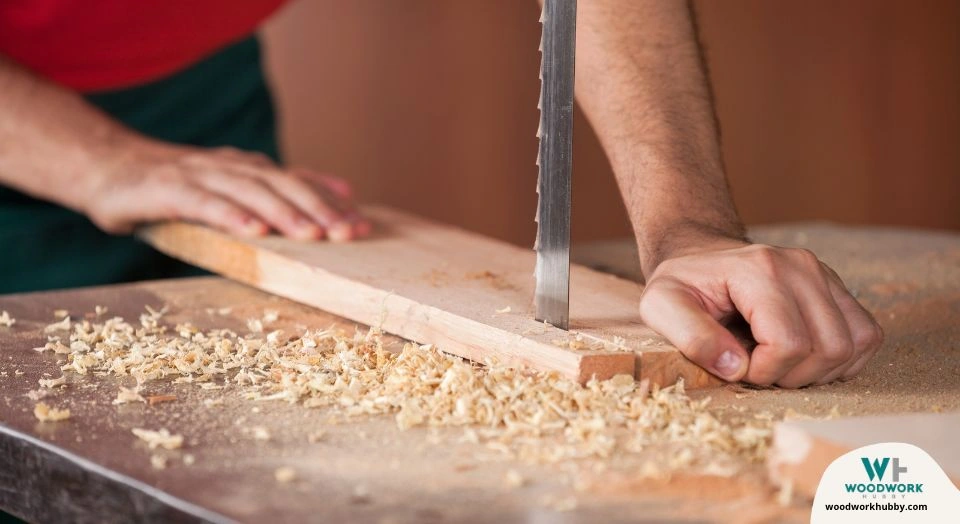
Cause
Force is a common utility used by the operator to feed the material through the blade. The amount of force used affects the straightness and speed of the cut. Using too much of that force while feeding the material through will cause the blade to twist and cut in a crooked fashion.
It goes off the assigned path because the blade and teeth are looking for a way to release the tension that is there. It can also be caused by not using enough force.
Fix
Achieving a straight line can take time, patience, and practice, but is worth it. This is done by lightly feeding the material into the cutting area. The light pressure and force will make a smooth transition and the least amount of tension against the blades.
The less tension you put on the blades the more likely they are to cut straight and not break. On the other hand, be sure to always steady the material and help guide it in the correct direction.
4. Tension on the Blade Is Too Tight/Loose
Cause
Blade tension is an important part of keeping the blade in place, but it can be an issue if it is too loose or too tight. Having a loose blade tension will cause the blade to twist and wobble. By twisting, this sends the blade off course and is difficult to control. Having a tight blade tension will cause the blade to slide, heat the wheel bearings, and can even break under a heavy load.
Fix
To check the tension of the blade, push it on one side with gloved hands. If the blade is pushed more than 1/4″ of the way, tighten the blade. The recommendation for a common carbon-steel blade tension is between 15,000 psi to 20,000 psi.
However, there are many different blades out there that are used and need a higher blade tension. The higher tension is usually in the range of 25,000 psi to 30,000 psi.
This video will show you exactly how to tension your bandsaw blade.
5. Blade Guides Are Out of Place
Blade guides are elements that keep the blade in line. These can be wheels, sliding blocks, or a combination of both. There is one on each side of the blade and one on the rear of the blade.
Cause
When the rear guide is being pressed against the blade while the machine is running, it is too far forward. This can cause the blade to shift from its natural position, causing poor cuts. If the rear guide is seriously out of place, then it can push the blade out of the crown wheel.
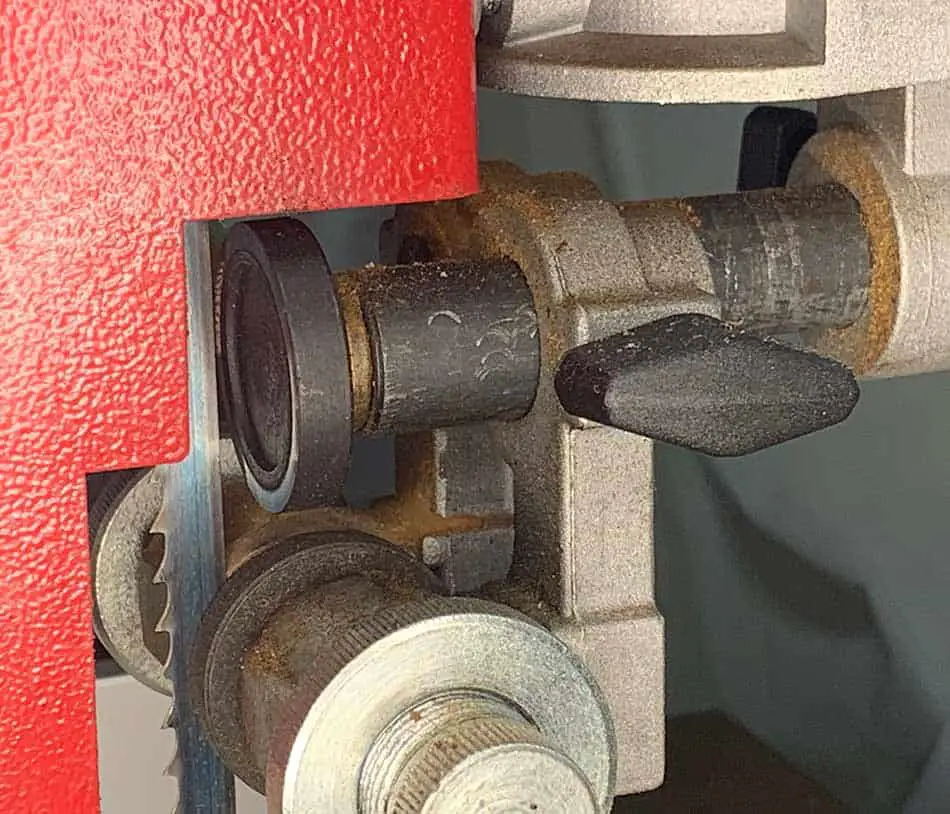
If the blade is pressed against the side guides too hard, that may also lead to poor cuts. This will also wear down the blade to a shortened blade life and guide life. When they are rubbing up against the wheels, it gets hot enough to distort the blade.
Fix
There is no set measurement for adjusting the blade guides and how far away they need to be from the blade. The guides will need to be adjusted depending on the thickness of the blade.
You can start adjusting it by taking the block off and moving every piece one hair closer or farther away from the blade. Put the block back on and see if the guide is the correct distance from the blade. If not, start the process again until it is correct.
6. Sawing Too Fast
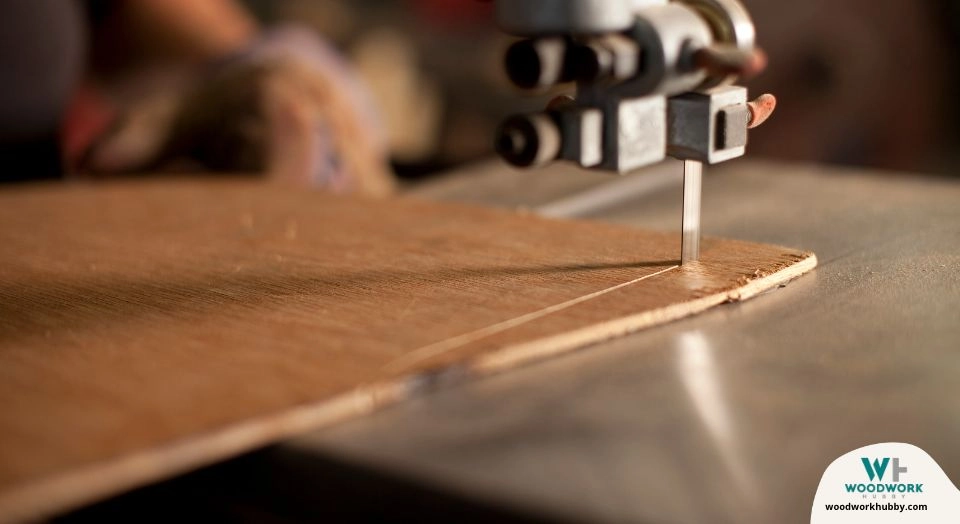
Cause
If you are not exactly sure what speed you are running and need to be running your bandsaw, you will find that it is incredibly important that you figure out the correct speed. The speed depends a lot on the material you are cutting—if you are cutting wood, you can cut faster, and if you are cutting metal, you should cut slower. If you are going too fast for your material, it will be really hard to get a straight line.
Fix
Figure out where on your particular bandsaw to adjust the speed. Then adjust it accordingly. For wood, your speed should be around 3000 feet per minute, while for metal the speed should be closer to 1500 feet per minute. Adjust accordingly.
7. Blade or Machine Is Too Hot
Cause
Heat on a blade can be caused by the material pinching the blade and causing friction. Friction is caused when the blade begins rubbing against the side of the machine or even against the wood.
Once it does this, the blade becomes much more likely to dull and the blade may no longer cut in a straight line. To prevent this, be sure all of your equipment is the correct size and attached properly. Several things could cause friction that would need to be fixed, but it could also be just from cutting wood for a prolonged period of time.
Fix
To ensure that you are not getting too much friction, see the steps above as a lot of those same problems could be causing friction. Fix any broken nuts or bolts, and make sure you have the proper sizes of blades.
It may also help to cool the saw down by applying lubricant. As a matter of fact, it should be applied quite regularly, regardless, to keep everything in working order.
8. Blade Has Been Installed Wrong
Cause
If there are things that have been installed incorrectly on your bandsaw, it is bound to be a problem at one point or another. One of the main installment issues is that the blades are facing the wrong way. The pointy end of the blade should always be pointed into the wood so that it is being cut and not damaging the blade.
Fix
Look at your blades to make sure the teeth are going in the right direction. You can tell if the blades are installed backward by looking to see which way the point is facing. Look from the top and see if you see the points coming at you, or if you see them being shoved into the material. If it is wrong, you can flip the blade over and re-secure it to get it to work.
9. Blade Is Going the Wrong Direction
Cause
This is about the same for the wrong type of installment but can be fixed another way. When wiring on bandsaws is messed with, this will sometimes cause some problems. They may immediately be prevalent, or they might not be noticed for a while, but as with everything else, if the wiring and electricity part isn’t working correctly, eventually something will need to be fixed. This is the case with the direction of the saw, if the blade is pulling up on the wood or metal is cut, then it is more likely to go off course and not cut straight. Watch your blade to determine if the tines of the blade are being pushed down or up.
Fix
This can be fixed by calling an experienced electrician/bandsaw repair worker, as they will have to rearrange the wires so that the blade starts going in the right direction. The blade should always be pushing the tines down into the wood, which causes it to be pushed into the table and not away from it.
Once you find a certified electrician, they should be able to rewire the bandsaw to push the blade down and not out, fixing the direction as well as the straightness of the cuts you make.
10. Bandsaw Wheel Is Worn Out
Cause
Over time, the wheel on the bandsaw will begin to wear out. The main thing that normally goes out is the crown, which is what is holding the blade in place, Most of the time the blade is right at the center, but if the crown begins to wear out, it may start allowing more and more movement, causing the blade to not cut in a straight line.
The crown is what allows the blade to track correctly with the wheel and both of these may need to be adjusted.
Fix
This can be fixed by ensuring that the crown on your bandsaw is the correct width for your blade. It may also help to get a new band saw wheel if the crown doesn’t seem to be the problem. Finally, after fixing both of those, you should be able to cut in a much straighter line.

